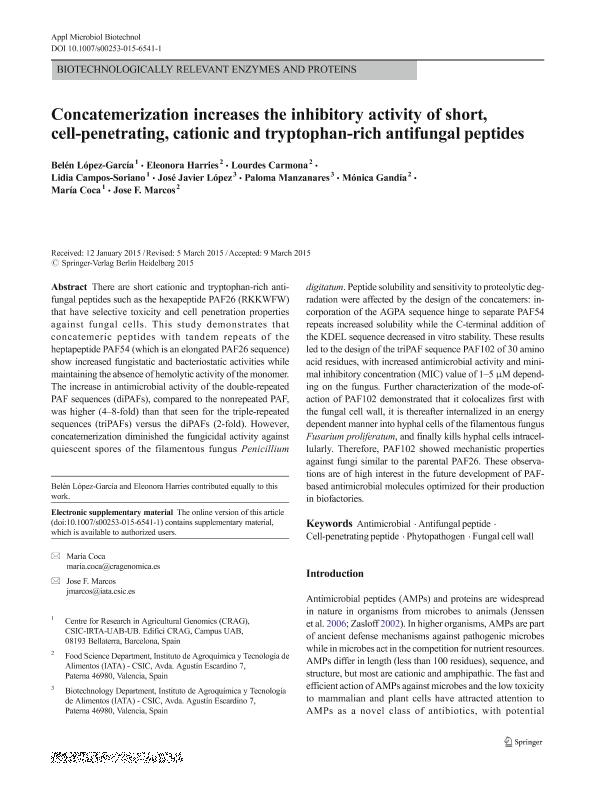Artículo
Concatemerization increases the inhibitory activity of short, cell-penetrating, cationic and tryptophan-rich antifungal peptides
Lopez Garcia, Belén; Harries, Eleonora del Milagro ; Carmona, Lourdes; Campos Soriano, Lidia; López, José Javier; Manzanares, Paloma; Gandía, Mónica; Coca, María; Marcos, Jose F.
; Carmona, Lourdes; Campos Soriano, Lidia; López, José Javier; Manzanares, Paloma; Gandía, Mónica; Coca, María; Marcos, Jose F.
 ; Carmona, Lourdes; Campos Soriano, Lidia; López, José Javier; Manzanares, Paloma; Gandía, Mónica; Coca, María; Marcos, Jose F.
; Carmona, Lourdes; Campos Soriano, Lidia; López, José Javier; Manzanares, Paloma; Gandía, Mónica; Coca, María; Marcos, Jose F.
Fecha de publicación:
04/2015
Editorial:
Springer
Revista:
Applied Microbiology And Biotechnology
ISSN:
0175-7598
Idioma:
Inglés
Tipo de recurso:
Artículo publicado
Clasificación temática:
Resumen
There are short cationic and tryptophan-rich antifungal peptides such as the hexapeptide PAF26 (RKKWFW) that have selective toxicity and cell penetration properties against fungal cells. This study demonstrates that concatemeric peptides with tandem repeats of the heptapeptide PAF54 (which is an elongated PAF26 sequence) show increased fungistatic and bacteriostatic activities while maintaining the absence of hemolytic activity of the monomer. The increase in antimicrobial activity of the double-repeated PAF sequences (diPAFs), compared to the nonrepeated PAF, was higher (4-8-fold) than that seen for the triple-repeated sequences (triPAFs) versus the diPAFs (2-fold). However, concatemerization diminished the fungicidal activity against quiescent spores of the filamentous fungus Penicillium digitatum. Peptide solubility and sensitivity to proteolytic degradation were affected by the design of the concatemers: incorporation of the AGPA sequence hinge to separate PAF54 repeats increased solubility while the C-terminal addition of the KDEL sequence decreased in vitro stability. These results led to the design of the triPAF sequence PAF102 of 30 amino acid residues, with increased antimicrobial activity and minimal inhibitory concentration (MIC) value of 1-5 μM depending on the fungus. Further characterization of the mode-of-action of PAF102 demonstrated that it colocalizes first with the fungal cell wall, it is thereafter internalized in an energy dependent manner into hyphal cells of the filamentous fungus Fusarium proliferatum, and finally kills hyphal cells intracellularly. Therefore, PAF102 showed mechanistic properties against fungi similar to the parental PAF26. These observations are of high interest in the future development of PAF-based antimicrobial molecules optimized for their production in biofactories.
Palabras clave:
Antifungal
,
Peptide
,
Penicillium
,
Fusarium
Archivos asociados
Licencia
Identificadores
Colecciones
Articulos(CCT - SALTA-JUJUY)
Articulos de CTRO.CIENTIFICO TECNOL.CONICET - SALTA-JUJUY
Articulos de CTRO.CIENTIFICO TECNOL.CONICET - SALTA-JUJUY
Citación
Lopez Garcia, Belén; Harries, Eleonora del Milagro; Carmona, Lourdes; Campos Soriano, Lidia; López, José Javier; et al.; Concatemerization increases the inhibitory activity of short, cell-penetrating, cationic and tryptophan-rich antifungal peptides; Springer; Applied Microbiology And Biotechnology; 99; 19; 4-2015; 8011-8021
Compartir
Altmétricas



